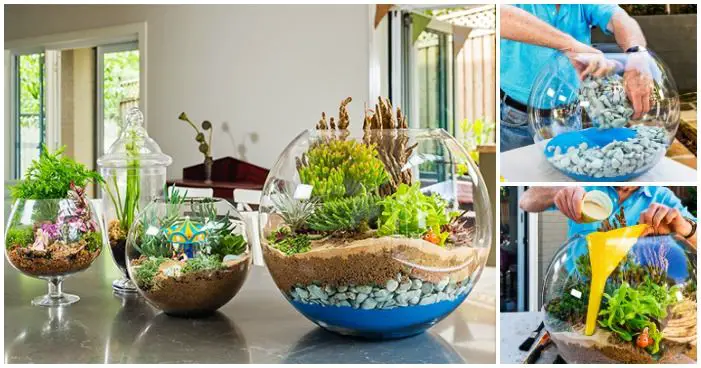The DIY terrarium is a great idea. It is not only pretty and decorative, but also a great way to be closer to nature on a daily basis.
Terrariums have been a passing fad since the mid-1800s and have always captured the human imagination. Regardless of their current popularity, these little curiosities are a great addition to any home decor, a great way to connect with nature during the colder months and a very rewarding hobby.
What is a DIY terrarium?
The terrarium, open or closed, is usually a glass container with substrate and plants a few inches thick arranged on the bottom.
Its idea is to create a confined environment imitating the biotope of certain plant and/or animal species. It can be compared to an aquarium where the water is replaced by a substrate such as earth or sand.
Terrariums are often kept as decorative or ornamental objects.
First, we will briefly introduce you to how to create a DIY terrarium yourself. We will list the plants suitable for the closed terrarium and those for the open terrarium. Then, we will look at the materials and tools needed to make it. Finally, we will present the different configurations of open, closed and wall terrariums.
Making a DIY terrarium is easy!
And yes, the DIY terrarium is really easy to make. Making it yourself requires only a few simple materials and tools as well as patience. You can also buy it in kit form in specialized stores.
The principle of its realization is quite simple: in a glass container, you make substrate or water and place the plants. The final declaration is optional. You can add small pebbles, rocks or other objects that seem suitable.

There are two types of terrariums: open and closed.
Open and closed terrariums differ mainly in the plants they house. In a closed terrarium, you would place plants that like shade and humidity.
While in the open terrarium, you can place flowering plants that like light. Indeed, it can be difficult to choose terrarium plants as there are many options. The terrarium plants listed here are so easy to grow that even a complete novice can succeed.
The closed terrarium
Closed terrariums are a little more complicated to maintain and less common. They must be kept mostly in the shade.
Moss, ferns and most of the small plants in the houseplant section of a nursery come from the shady habitat of the forest floor and will do well in an enclosed terrarium because they like moisture.
Because of the low moisture loss, the enclosed terrarium can stay alive and well for months without maintenance. Plants such as succulents would not be suitable for an enclosed terrarium.
Open terrariums
The DIY open terrarium is more like a glass planter than a traditional terrarium”. In addition to all the plants used in closed terrariums, you can also plant orchids, small houseplants, etc. You can also make succulent terrariums using small succulents and climbers that like the dry environment.
The open terrarium is the most common because it allows you to grow a wider variety of plants than the closed terrarium. However, it should be noted that some species of plants for open terrariums require more care.
Which plants for my DIY terrarium?
There is a wide variety of plants that you can use for your DIY terrarium. For a tropical terrarium, mosses, ferns, adiantum, davalias, deer horns or platycerium, tillandsias, asplenium nidus, some carnivorous plants or mini-orchids.
But also some climbing plants like epipremnum, ficus pumila and chlorophytum. These plants are only a small part of the big list. But it is safe to say that you will find most of them in almost every garden store as well as online.
For a desert terrarium DIY, you can opt for aloe vera, echeveria, gasteria, haworthia, Utah agaves or even Chinese lanterns. The latter, also known as sansevieria or ceropegia, is very resistant.
Lately, one of the most popular terrarium plants are tillandsias, commonly known as “air girls’ ‘. These plants require only a thin layer of potting soil, are very light and can be easily attached to any terrarium.

Case of the DIY orchid terrarium
Orchids are really pretty, but you have to remember that these flowering plants need special care. To succeed in a DIY terrarium with orchid(s), there are certain things you should focus on. For a terrarium, we usually choose orchid species for tropical environments. Water the orchid with lime-free water, mineral if possible.
Orchids need a concentrated fertilizer similar to that for tomatoes. The orchid needs a resting period during the winter so that it can bloom again. We recently dedicated an article to how to make an orchid bloom again. You can read it here.
Maintenance of the DIY terrarium
In principle, your terrarium will require very little maintenance: you will have to remove dead plants – stems, leaves… – to avoid any bacterial proliferation, use organic fertilizers, which will not leave salt deposits on the walls of the container, and water with the greatest of sparingness.
Finally, you can decorate your mini green space with small decorations. With the exception of some less light-tolerant species such as haworthia and gasteria, most succulents prefer bright, direct light. Place your succulent terrarium in a very bright location, keeping in mind that glass tends to magnify direct sunlight and can potentially burn your plants.
